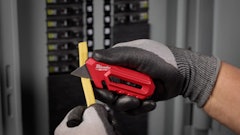
The New Jersey community that relies on the Grove Street Bridge will soon enjoy a rehabilitated, modern structure over Route 46. During the past year's construction, drivers and pedestrians experienced a streamlined traffic management system -- portable traffic signals working in conjunction with portable pedestrian signals.
Ritacco Construction of Belleville, NJ, used four pedestrian signals and two traffic signals manufactured by North America Traffic on a New Jersey Department of Transportation (NJDOT) bridge rehabilitation project. The construction required them to reduce traffic to a single lane across the bridge.
Over the past 17 years, contractors and agencies throughout the United States and Canada have used North America Traffic's portable traffic signal systems on more than 3,000 projects. The battery-powered signals can operate for a full week before recharging with the built-in charger. They take minutes to set up and are easily transportable between projects.
"Due to the traffic volume, emergency vehicle access requirements and proximity to schools we had to stage the construction, alternate traffic back and forth on one lane across the bridge and accommodate pedestrians," explained Giuseppe Gencarelli of Ritacco Construction.
The contractor recommended the use of a portable traffic signal system instead of a hardwire system to the NJDOT, because it allowed them to start the project ahead of schedule for roughly the same costs.
"Road construction isn't performed in a vacuum. The public generally sees it as a necessary evil, so we customize integrated systems to keep traffic and pedestrians moving," says Justin DiFrancesco, vice president at North America Traffic.
In New Jersey, all six signals worked through an automated system that ran 24 hours a day, seven days a week. The traffic signals were set in a sequence that alternated the traffic across the bridge. The pedestrian signals remained on standby until a person pushed the "Walk" button. Then, the timing sequence was interrupted and traffic stopped to allow the pedestrian to cross. Once the pedestrian was across, the traffic signals went back to the original sequence.
The signals also met local requirements for emergency vehicle access on the bridge. Programmed to recognize a siren, the signals can distinguish the direction from which an emergency vehicle is coming and clear the traffic appropriately.
One final benefit of the portable signal system Ritacco utilized on this project was the hand-held remote, which allowed them to override the automated system when necessary. "With the handheld remote, we were able to stop traffic to bring equipment in and out of the jobsite when needed," Gencarelli noted.
The devices ran for months and will be removed at the project's completion. Gencarelli says the contractor will recommend the signals on other similar projects, "We had no issues with the signals and, in construction, that's a win!"
North America Traffic signals offer other integrated features such as a video detection system and default warning systems which operate from cellular or even satellite for customers in remote regions.
About North America Traffic
North America Traffic was launched as R.C. Flagman in 1993 when Peter Vieveen built the world's first Remote Controlled Flagman(TM) out of his garage. At the time, Mr. Vieveen was a senior estimator in the construction industry with over 25 years of construction experience. He understood the importance of reducing costs while increasing safety. North America Traffic now operates a full production facility, and its products have been used on over 3,000 projects across North America. Today, it is the world leader in traffic control systems, with 8 different models of portable traffic signals and flagging systems to meet all traffic control needs. For more information, visit www.NorthAmericaTraffic.com.



















